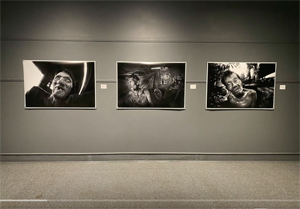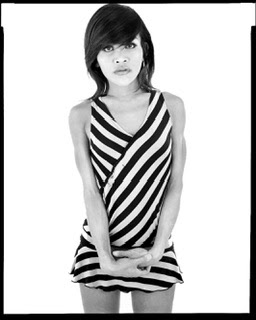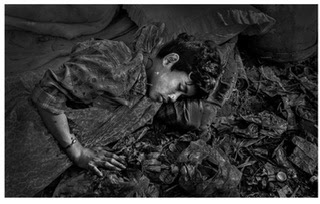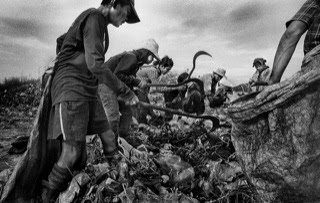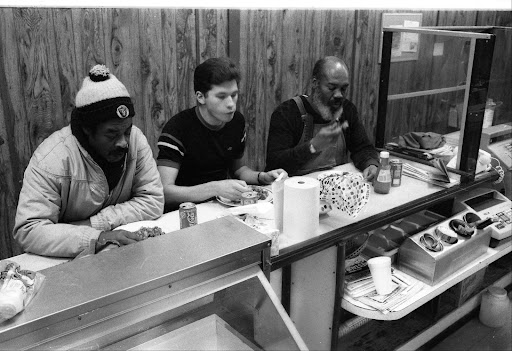"By varying the position of his camera, his camera angle, or the focal length of his lens, the photographer can achieve an infinite number of varied compositions with a single, stationary subject. By changing the light on the subject, or by suing a color filter, any or all of the values in the subject can be altered. by varying the length of exposure, the kind of emulsion, the method of developing, the photographer can vary the registering of relative values in the negative. And the relative value as registered in the negative can be further modified by allowing more and or less light to affect certain parts of the image in the printing. This, within the limits of his medium, without resorting to any method of control that is not photographic (i.e., of an optical or chemical nature), he photographer can depart from the literal recording to whatever extent he chooses.
This very richness of control facilities often acts as a barrier to creative work. The fact is that relatively few photographers ever master their medium. Instead they allow the medium to master them, and go on an endless squirrel cage chase from new lens to new paper to new developer to new gadget, never staying with one piece of equipment long enough to learn its full capacities, becoming lost in a maze of technical information that is of little or no use since they don't know what to do with it.
Only long experience will enable the photographer to subordinate technical considerations to pictorial aims, but that can be made immeasurably easier by selecting the simplest possible equipment and procedures and staying with them. Learning to see in terms of field of one lens, the scale of one film and one paper, will accomplish a deal more than gathering a smattering of knowledge about several different sets of tools.
The photographer must learn from the outset to regard his process as a whole. He should be concerned with the right exposure, the perfect negative. Such notions are mere products of advertising mythology. Rather he must learn the kind of negative necessary to produces a given kind of print, and then the kind of exposure and development necessary to produce that negative. When he knows how these needs are fulfilled for one kind of print, he must learn how to wary the process for other kinds of prints......."
"Good composition is only the strongest way of seeing the subject. It cannot be taught because, like all creative effort it is a matter of personal growth."
"In common with other artists the photographer wants his finished print to convey to others his own response to his subject. In the fulfillment of this aim, his greatest asset is the directness of the process he employs. But this advantage can only be retained if he simplifies his equipment and technic to the minimum necessary, and keeps his approach from from all formula, art-dogma, rules and taboos. Only then can he be free to put his photographic sight to use in discovering and revealing the nature of the world he lives in."
Here is a longer version of the Edwards Essay:
http://www.jnevins.com/westonreading.htm
skip to main |
skip to sidebar
I have been thinking of why I love photography, it comes down to something I have labeled "The Three Joys"
1) Creativity
The first joy is simply creating the work. Everything about the making of photographs I love. The initial ideas, the writing on the blog, the preparation of equipment, the research into my subjects, figuring out what I want to communicate. The camera tech stuff like composition, lens selection, cameras, figuring exposure, taking the shot etc. The post darkroom work where you swim with your prints bringing them slowly to life, creating something powerful and beautiful. I love it all.
It is so powerful a thing, you have a idea in your mind, there is nothing else, then YOU make it, you create it, it's fricking awesome stuff.
2) The People
The second joy is that photography has allowed me a way into so many peoples lives, so many different worlds. I get to meet people of all types, speak to them, eat with them, cry and laugh with them. For a while I get to live their existence to be them if you will.
I get to be a child in a slum in Bangkok or a drug addict in a ghetto in Oakland. I get to be a ladyboy sex worker in Pattaya or a man dying of cancer in Canada. Of course I am not really those people but I get a true flavor for those worlds, those experiences, the good and the bad, the ugly and the beautiful, the joy and the sadness.
With photography I get a chance to live outside of the same same everyday meat and potato lives many of my friends and family live. Because I use a camera and make pictures all the doors to a wonderful life experience are open to me, photography is a window into everything!
3) The Photograph
The third joy is about the feeling you get when you accomplish your goals, when you see your final print in the developer, fix or hanging in a gallery. There is a special emotion there, a true satisfied happiness, something so uniquely rewarding. In the darkroom sometimes when I see the finished photo for the first time as it lays in the fixer tray I will let out hoops of joy. I will scream and shout. It is quite a spectacle! It's just the sheer high of that moment bursting out, the YES moment. When the photo is right and you see it for the first time it's the best feeling in the world, better than anything I have ever felt, the high of highs!!
"Ain't Photography Grand!"
"Ain't Photography Grand!!"
Social Documentary Photography for a Better World!
Search This Blog
Contact Gerry Yaum
contact@gerryyaum.net
Gerry Yaum Interview, FRAMES PHOTOGRAPHY MAGAZINE YouTube Channel
"Black & White" Photography Magazine, Issue #160
BLACK &WHITE Magazine, Layout Feature
CENTRE for BRITISH DOCUMENTARY PHOTOGRAPHY, CBDP
St. Albert Gazette MY FATHERS LAST DAYS Story
Me, W. Eugene Smith, Sebastiao Salgado, Lewis Hine and Walker Evans! :) NOT!!!
LUNCHBOX Radio Interview FOR UNB EXHIBITIONS
MONEY EARNED TO HELP THE PEOPLE IN THE PICTURES
Money that will be used to directly help the people in our two photography projects, THE FAMILIES OF THE DUM and THE PEOPLE WHO LIVE UNDER THE FREEWAY $6334.67 ($6000 earned when 6 prints were added to the UNB permanent collection).
GOFUNDME, FAMILES/FREEWAY
Trying to raise $2000 to help the people under the freeway, and the families of the dump. TOTAL RAISED SO FAR = $325 —->$314.67 (after GOFUNDME fees).
UNIVERSITY OF NEW BRUNSWICK EXHIBITIONS VIDEO
Analog Forever Magazine
Vernon Morning Star Newspaper Story
2022 "Families of the Dump"/The People Who Live Under The Freeway Donation Buys
Total donation money spent for the 2022 trip to the Mae Sot dump (THE FAMILIES OF THE DUMP), Bangkok's Klong Toey Slum (THE PEOPLE WHO LIVE UNDER THE FREEWAY). Money spent on "The Families of the Dump" = $571.17 CAD (14982 Thai Baht) Money spent on "The People Who Live Under The Freeway = $144 CAD (3849 Thai Baht) General cases where money was spent to help others in need $15 CAD (401baht)
(Thai Currency) or
CAD
"Families of the Dump" Donation Total
$4420.02 CAD
GERRY YAUM: YouTube Video PHOTOGRAPHY CHANNEL
THE GOAL
To create photographs that speak to the universality, the commonality and the shared humanity of all peoples, regardless of country, race, culture or language.
TRANSLATE YAUM'S PHOTO DIARY INTO YOUR LANGUAGE
Quote: Robert F. Kennedy
“The purpose of life is to contribute in some way to making things better.”
Quote: Nelson Mandela
"As long as poverty, injustice and gross inequality persist in our world, none of us can truly rest."
Quote: Weegee (Authur Fellig)
"Be original and develop your own style, but don't forget above anything and everything else...be human...think...feel. When you find yourself beginning to feel a bond between yourself and the people you photograph, when you laugh and cry with their laughter and tears, you will know your on the right track....Good luck."
Blog Archive
-
▼
2012
(483)
-
▼
August
(27)
- The Truth Is Beautiful
- Joys Of Music
- 8x10 Tri-x Buy
- Grant Submitted
- Quote: Jock Sturges
- Spoke To Jock
- Banarama 2 And Flash
- Why?
- The Use of Space In Large Format Portraits
- Site Advertising Money
- Being Open
- Learning The 8x10
- Quote: Richard Benson (Photographer)
- More Older Scans
- A Few Pics
- Dips and Trips
- Studying Jock
- In The Works?
- Up All Night
- Mido II Holders!?
- 3 Very Different People Picture Subjects
- Dancing The Night Away
- Another Try
- Printing Better Now
- Quotes: Edward Weston (From "Seeing Photographical...
- Quote: Vincent Van Gogh
- Quote: Roger Ebert
-
▼
August
(27)
Total Pageviews
The Three Joys Of Photography
The Three Joys
1) Creativity
The first joy is simply creating the work. Everything about the making of photographs I love. The initial ideas, the writing on the blog, the preparation of equipment, the research into my subjects, figuring out what I want to communicate. The camera tech stuff like composition, lens selection, cameras, figuring exposure, taking the shot etc. The post darkroom work where you swim with your prints bringing them slowly to life, creating something powerful and beautiful. I love it all.
It is so powerful a thing, you have a idea in your mind, there is nothing else, then YOU make it, you create it, it's fricking awesome stuff.
2) The People
The second joy is that photography has allowed me a way into so many peoples lives, so many different worlds. I get to meet people of all types, speak to them, eat with them, cry and laugh with them. For a while I get to live their existence to be them if you will.
I get to be a child in a slum in Bangkok or a drug addict in a ghetto in Oakland. I get to be a ladyboy sex worker in Pattaya or a man dying of cancer in Canada. Of course I am not really those people but I get a true flavor for those worlds, those experiences, the good and the bad, the ugly and the beautiful, the joy and the sadness.
With photography I get a chance to live outside of the same same everyday meat and potato lives many of my friends and family live. Because I use a camera and make pictures all the doors to a wonderful life experience are open to me, photography is a window into everything!
3) The Photograph
The third joy is about the feeling you get when you accomplish your goals, when you see your final print in the developer, fix or hanging in a gallery. There is a special emotion there, a true satisfied happiness, something so uniquely rewarding. In the darkroom sometimes when I see the finished photo for the first time as it lays in the fixer tray I will let out hoops of joy. I will scream and shout. It is quite a spectacle! It's just the sheer high of that moment bursting out, the YES moment. When the photo is right and you see it for the first time it's the best feeling in the world, better than anything I have ever felt, the high of highs!!
"Ain't Photography Grand!"
Contact Gerry
- Gerry Yaum
- Edmonton, Alberta, Canada
- Email Gerry: gerryyaum@gmail.com
"Can a photograph stop a war? Can it save a life? Can it lead to understanding, inspire someone to help, provide comfort and open the door to compassion?
Hope that it can.
Pray that it can."
Hope that it can.
Pray that it can."










